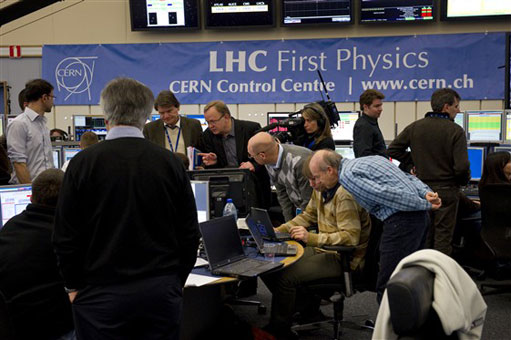
ATLAS e-News
23 February 2011
Colliding with the media
13 April 2010

Excitement in the CERN Control Centre
Bringing high-energy proton beams into collision in the LHC has been described by CERN’s Director of Accelerators and Technology, Steve Myers, as ‘like firing needles across the Atlantic and getting them to collide halfway’. But getting particle physics and the mass media to collide and, crucially, to understand where each other is coming from, is a rare feat in itself. So how did those involved with the media on March 30th get on…?
“They didn’t really ask any tough or surprising questions,” remembers Johanna Fleckner, who spent the day looking after two German TV crews. “They were very interested, and tried hard to understand and get all the facts right.”
Appreciating one another’s working timeframes was a little more tricky, of course: the journalists needed their stories quick, in order to secure their spots in the daily news agenda, but the physicists knew that this day would require patience.
“They were really disappointed [when there was a beam dump],” says Johanna. “A lot more disappointed than we were! We knew that it would take some time, and that if we got collisions by the afternoon, it would be really something amazing. But they were expecting: 7 a.m., arrive, let’s see the collisions!”
The questions may not have been technically tricky, but it’s the ‘human’ side of a story that hooks readers, listeners, and viewers. This is particularly important when trying to convey something as large, extraordinary, and scientifically baffling as the LHC project to the world at large, but it wasn’t something that people here were necessarily prepared for.
US LHC blogger Adam Yurkewicz was surprised that the US Associated Press journalist he was assigned to recognised him from reading his blog. The German print press stunned Andi Salzburger by asking if he had been a child prodigy, like his countryman Mozart. And Johanna was asked to comment on how people felt about the collision-free year, and whether or not she personally planned to stay in physics.
The big overarching questions received lots of attention, too, with the journalists trying to sniff out facts and identify concrete goals in a sea of unknowns. ‘When will humankind really gain something from this?’, was the toughest question Andi faced, and Adam was asked in detail about the accelerator commissioning plans and to specify how long it would take to discover ‘something’.
Overall though, the ATLAS media contacts were left with a positive impression of keen and interested journalists who were doing their best to get their stories straight.
“They would tell me, ‘OK that was good, but give it again without so much detail. Try to make it shorter’,” says Johanna. “That was really nice. They really gave me the time I needed to get it perfect, so I didn’t feel too pressured.”
On the other side of the glass, in the Control Room itself, the pressure was managed much better than it was for the first media event in 2008, according to Monica Dunford.
“Last time, there were people running round the Control Room with cameras, and it was… It was fun, but if there had been problems with the detector, it would have been difficult. This year they did a really good job of entertaining the press, outside of the Control Room itself.”
And a good thing that was too, as Monica describes the moments when the separation gap between the beams was collapsed as “like watching a horror film”.
“I had thought that collapsing would be like BAM! Done. But no, the beams were slowly coming together, coming together… It must have been 30 seconds, but it felt like infinity. I had my hands in front of my face, and I remember taking deep breaths. I was just totally on edge. Then as soon as the beams were on the same level, everything just started going crazy in the Control Room. In a good way: the Trigger rate going up, Minimum Bias events coming up on the event screens, everything just responding exactly how you wanted it to do.”
“The good news took about 30 seconds reach those of us in the right-hand corner of the packed Control Room,” recalls Pauline Gagnon. “We couldn’t see the Trigger rate turning up on the screen on the other side of the room, so we had no indication that the collisions were taking place, other than the cheers we could hear. But then the first collision appeared on the Event Display and we started cheering in earnest too!”
At that point, it was ‘action stations’, as everyone was keen to get on and start studying the first plots. With the media outside of the Control Room, people were able to focus and get on immediately.
“It was hard to see how the media reacted actually, because they were behind the screen,” says Monica. “But they rarely respond, because they’re so intense in capturing it. They’re very focussed at that point. When our job kind of ends, and we can celebrate, their job is just beginning.”
 Ceri PerkinsATLAS e-News
|